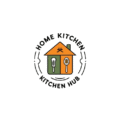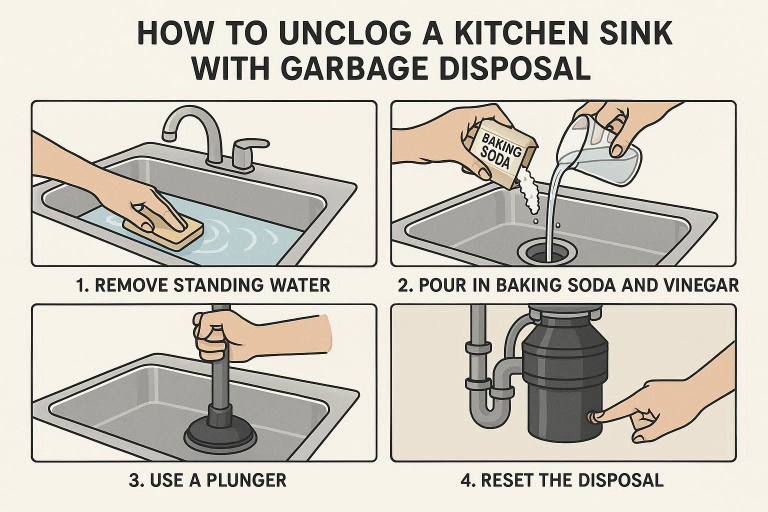A clogged kitchen sink with a garbage disposal is a common household nuisance that can bring your daily kitchen routine to a halt. Whether it’s the result of food buildup, grease, or an unexpected foreign object, dealing with a clogged disposal can be frustrating. The good news is that many of these clogs are easy to fix with some simple DIY methods, and you can often get your kitchen sink back to normal without needing a plumber.
In this guide, we’ll take you through the main techniques and tools you’ll need to unclog a kitchen sink with a garbage disposal. From addressing standing water to dealing with slow drainage, we’ll walk you through each step of the process.
Understanding Why Your Kitchen Sink with Garbage Disposal Gets Clogged
Common Causes of Clogs in a Garbage Disposal
Garbage disposals are handy, but they aren’t foolproof. There are a few common reasons your kitchen sink with a garbage disposal might clog:
- Food Buildup: Over time, food scraps can build up in the disposal or drain lines, restricting the flow of water and causing a clog.
- Grease and Fat: Pouring grease or fat down the disposal can harden in the pipes, creating blockages.
- Foreign Objects: Non-food items such as utensils, small bones, or hard materials can get stuck in the disposal and lead to clogs.
How Improper Use of the Garbage Disposal Can Lead to Clogs
Improper use, like overloading the disposal with large Cleaning Guide for Home & Kitchen amounts of food at once, or using it to grind up items that it isn’t designed for (like fibrous vegetables, rice, or coffee grounds), can cause clogs. Additionally, not running enough water with the disposal can lead to food scraps becoming stuck in the pipes.
Signs of a Clogged Kitchen Sink
A clogged kitchen sink doesn’t always appear immediately. Here are some tell-tale signs:
- Slow Drainage: If your sink is draining slowly, it could indicate a partial clog in the drainpipe or garbage disposal.
- Standing Water: If you’re seeing standing water in the sink, the clog is more severe and is likely obstructing the drainage path entirely.
- Foul Odors: A persistent bad smell from the sink or disposal is a clear sign that food particles or grease are trapped and decomposing.
How to Unclog a Garbage Disposal with Standing Water
When you notice standing water in your sink, it means the water can’t flow through the drain due to a clog. Here’s how to address this issue:
Step 1: Turn Off the Power
Before you do anything, safety is paramount. Unplug the garbage disposal or turn off the circuit breaker to prevent accidental activation while you’re working.
Step 2: Remove Standing Water
Use a cup, bowl, or small container to remove as much standing water as possible. You can also use a wet/dry vacuum if you have one, which will make the task quicker.
Step 3: Use a Plunger
Place a sink plunger over the drain and create a tight seal. Begin plunging up and down vigorously, using quick, forceful motions. The suction and pressure should help dislodge the blockage. You might need to repeat this process a few times.
Step 4: Check for Blockages
Once you’ve applied a few plunges, check for any visible debris. Use a pair of tongs or pliers to carefully remove any food scraps or other objects stuck in the disposal or drain.
Step 5: Check the Disposal’s Drain Line
If plunging hasn’t worked, it’s time to inspect the drain line. If there’s a visible blockage, you can try to clear it with a pipe snake or plunger. Sometimes the problem lies within the drainpipe, so clearing that could resolve the issue.
How to Fix a Slow Draining Kitchen Sink with Garbage Disposal
If your sink is draining slowly, it’s a sign that there’s a partial blockage somewhere in the system. Here’s how to fix it:
Why Does My Sink Drain Slowly with a Garbage Disposal?
Several factors can cause slow drainage, including:
- Partially blocked pipes from food buildup or grease.
- A clog in the garbage disposal preventing water from flowing freely.
- The drain pipe being obstructed by food scraps or other debris.
How to Clear the Clog
- Step 1: Use a Plunger: If you notice slow drainage, begin by using a plunger to loosen any blockages. Plunge vigorously and ensure you get a tight seal.
- Step 2: Use an Allen Wrench: If the clog seems to be within the garbage disposal, use an Allen wrench to manually rotate the disposal blades. This can help loosen any stuck debris.
- Step 3: Snake the Drain: If the clog is in the pipes, you can try using a drain snake or auger to break up the obstruction.
Preventing Future Clogs
- Avoid Putting Certain Items Down the Disposal: Grease, fats, coffee grounds, and fibrous vegetables can clog the disposal over time.
- Run Cold Water: Always run cold water when using the disposal. Cold water helps solidify grease, allowing it to be chopped up more effectively by the disposal.
How to Unclog a Garbage Disposal Without Taking It Apart
You don’t always need to disassemble the garbage disposal to clear a clog. Here’s how to try and fix it without taking it apart:
Step 1: Check for Obstructions
Look inside the disposal with a flashlight to identify any visible blockages. Avoid using your hands, as the disposal blades may be sharp.
Step 2: Use a Wooden Spoon or Tongs to Clear the Obstruction
Use a long, sturdy wooden spoon or tongs to gently dislodge the obstruction. Never use your hands to try and remove debris.
Step 3: Run Hot Water
Turn on the faucet to run hot water through the disposal for several minutes. Hot water helps dissolve grease and fat, making it easier to break up blockages.
Step 4: Use Baking Soda and Vinegar
Pour half a cup of baking soda and half a cup of vinegar into the drain. Let the mixture sit for about 15-20 minutes before flushing it with hot water. The fizzing action can help break down any food particles or grease blocking the pipes.
Step 5: Reset the Disposal (if Necessary)
If the disposal is still jammed after clearing any visible debris, try resetting it. Look for a reset button at the bottom of the unit and press it to restore power to the disposal.
Kitchen Sink Only Drains When Garbage Disposal Is On
This can be a puzzling issue, but it’s not uncommon. Here’s how to fix it:
What Does It Mean When My Sink Only Drains with the Garbage Disposal On?
This often happens when there’s a problem with the drain line or P-trap, or if there’s an airlock in the drainpipe.
How to Fix It
- Step 1: Check the Drain Pipe and P-Trap: Remove the P-trap under the sink and check for any blockages.
- Step 2: Clear the Drain Line: If the drain line is clogged, use a pipe snake or plunger to clear it.
- Step 3: Check for Airlocks: Airlocks can prevent water from draining properly. If you suspect an airlock, try to clear it by plunging or loosening any fittings along the pipe.
When to Call a Plumber
If you’ve checked the P-trap and drain line and the issue persists, it might be time to call in a professional. A plumber can assess the situation and fix the underlying issue.
How to Unclog a Kitchen Sink Without Garbage Disposal
If your sink is clogged but doesn’t have a garbage disposal, here’s how to clear it:
Step 1: Use a Plunger
Place a plunger over the drain, ensuring it forms a tight seal. Use forceful up-and-down motions to loosen the clog.
Step 2: Check for a Blockage in the Drain Pipe
If plunging doesn’t work, inspect the drain pipe for visible blockages. Use a drain snake or auger to break up the clog.
Step 3: Use Baking Soda and Vinegar
Pour baking soda and vinegar into the drain to dissolve organic matter. Follow with hot water to flush the drain.
Step 4: Inspect the P-Trap
Remove the P-trap and clean out any debris that’s clogging it.
How to Unclog a Garbage Disposal Without Reset Button
If your garbage disposal doesn’t have a reset button, you can still unclog it using these steps:
Step 1: Power Off the Disposal
Unplug the garbage disposal or turn off the circuit breaker to ensure it’s not running while you work.
Step 2: Manually Rotate the Disposal
Use an Allen wrench to manually rotate the blades. This can help dislodge any stuck debris.
Step 3: Use Pliers or Tongs
Once you’ve manually rotated the blades, use tongs to remove any visible blockages.
Step 4: Run Water and Test the Disposal
Turn on the water and test the disposal to make sure it’s functioning properly after the blockage is cleared.
How to Handle a Clogged Kitchen Sink with Garbage Disposal and Dishwasher
If your sink, garbage disposal, and dishwasher are all affected, the issue might be with the shared drain line. Here’s how to address it:
Step 1: Check the Dishwasher Drain Hose
Inspect the dishwasher’s drain hose for any clogs and clean it if necessary.
Step 2: Use a Plunger on the Sink
Plunge the sink to clear the drain line that connects to both the disposal and the dishwasher.
Step 3: Check the P-Trap and Drain Line
Clean the P-trap and inspect the drain line for any obstructions.
Step 4: Call a Professional
If the clog persists and is affecting multiple appliances, it may be time to call a plumber for a professional assessment.
FAQ
Can I use a plunger to unclog a sink with a garbage disposal?
Yes, a plunger can help unclog a sink with a garbage disposal, but use it carefully to avoid damaging the unit.
How do I unclog a garbage disposal with standing water?
Turn off the power, remove the standing water, and then use a plunger to dislodge the blockage.
Why does my kitchen sink only drain when the garbage disposal is on?
This issue is usually caused by a blocked drainpipe, P-trap, or airlock. Try clearing the drain line or checking the P-trap.
How can I unclog a garbage disposal without a reset button?
Use an Allen wrench to manually rotate the disposal blades and dislodge the clog, then remove any visible obstructions with tongs.
What should I do if I have a clogged sink, garbage disposal, and dishwasher?
Check the dishwasher drain hose, plunge the sink, and inspect the P-trap and drain line for clogs.
How can I prevent my kitchen sink with garbage disposal from clogging in the future?
Regularly clean your disposal, avoid putting grease and fibrous foods down it, and run cold water while using it to prevent clogs.
Conclusion
A clogged kitchen sink with a garbage disposal can be a hassle, but with the right tools and techniques, most clogs can be cleared easily. From using a plunger to manually rotating the disposal, there are many ways you can tackle the problem yourself. However, always remember to prioritize safety and don’t hesitate to call a plumber if the clog persists. Regular maintenance and proper use of your garbage disposal can help keep your sink and disposal running smoothly for years to come.

